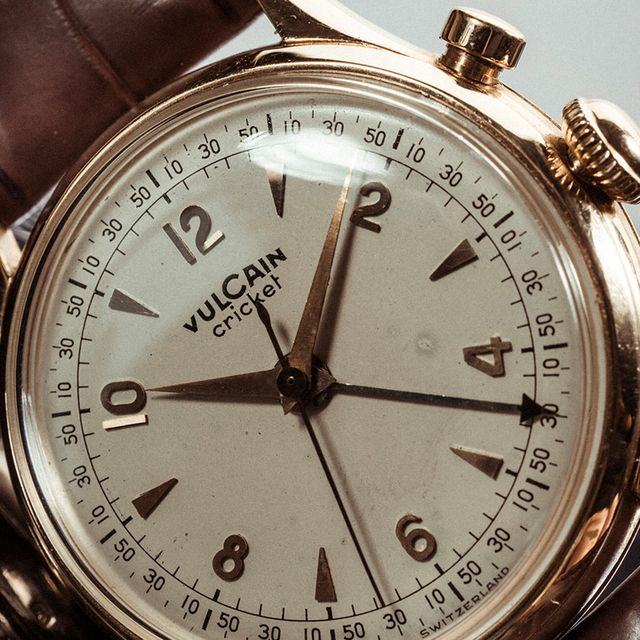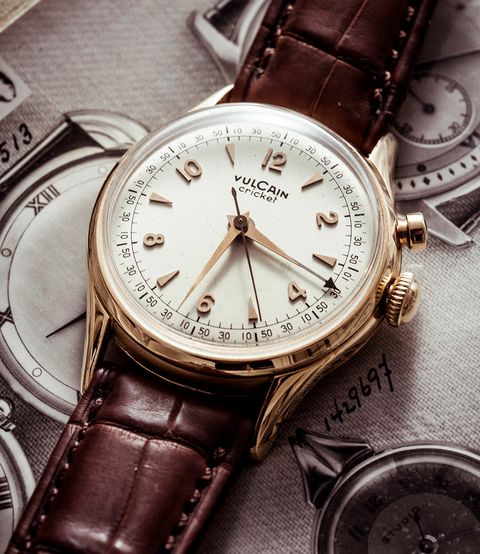Welcome to Watches You Should Know, a column highlighting little-known watches with interesting backstories and unexpected influence. This week: the Vulcain Cricket.
It’s hard to imagine today that the rattly buzzing sound of a mechanical wristwatch alarm was once cutting-edge gadgetry. This was in the 1940s, however, and when the Vulcain Cricket was introduced, it overcame a number of technical hurdles to be loud enough, compact enough, and reliable enough to be a viable product. The first of its kind, an alarm was a genuinely useful function to have on the wrist. So much so that it found fame and took on a whole other level of status after being worn by multiple US presidents and becoming known as the “president’s watch.”
"Firsts" in watchmaking are notable, but almost always require some qualification. The utility of an alarm on one’s wrist was recognized long before the Cricket, and a couple companies had produced alarm watches, but each had fatal flaws with alarms that weren’t loud enough or vibrations that adversely affected the movement. The Vulcain Cricket was not technically the first alarm watch when it was introduced in 1947, but the first to be practically successful (pocket watches notwithstanding).
Vulcain had to develop a special movement with multiple unique features in order to make the Cricket viable, let alone interesting and cool. The Caliber 120 featured one mainspring barrel to power timekeeping, as most mechanical wristwatches do, but also a separate one solely for the alarm due to its heavier power demands. The hand-wound movement offered 42 hours of power reserve for the timekeeping, and allowed the alarm to sound for around 25 seconds. Particularly clever is how clean and simple the watch remained despite its complex functionality: turn the crown one direction to wind the time’s mainspring and the other direction to wind the alarm’s mainspring.
The volume needed to be at least sufficient to wake you up, and this was achieved with a combination of solutions. The sound itself comes from a tiny hammer striking a metal “membrane.” It is then amplified via a cover which fits over the movement and, to let the sound resonate and escape, the case back is acoustically designed with holes similar to those seen in some string instruments. The hammer strikes around 1,300 times in the roughly 25 seconds of its loud, continuous ring until it audibly winds down — and it further vibrates palpably on the wrist.
All this results in a watch that looks pretty traditional, with only the addition of another hand on the dial for the alarm and a pusher at 2 o’clock that distinguishes it from time-only watches. The pusher is used to activate the alarm, stop it (important), and put the watch into alarm setting mode. One notable caveat is that the alarm can be set in ten-minute increments, but not down to an exact, individual minute.
The Cricket was successful and was followed by other notable alarm watches like the Jaeger-LeCoultre Memovox and the Tudor Advisor. The Cricket itself also evolved with additional functions and more versions. One of the most notable such Vulcain watches was the Cricket Nautical released in 1961, a dive watch rated to 300m with an alarm that would be audible to the wearer underwater.
The office of president of the United States is full of rituals and traditions, and Vulcain was lucky enough to become part of one. After the White House Press Photographer’s Association chose a Cricket to gift Harry S. Truman a 14k gold Cricket in 1953 as he was leaving office, the alarm watch continued to be associated with US presidents. Vulcain has been clever enough to send Cricket watches to US presidents as well, but this wasn’t a simple case of product placement — Nixon, it is said, got his as a gift from the National Association of Watch and Clock Collectors.
Lyndon B. Johnson clearly appreciated fine watches, as he is associated with both the Cricket and the other famous “president’s watch,” the Rolex Day-Date. Johnson bought his Cricket himself in Geneva, the story goes, and had his initials, LBJ, put right on the dial. He later also bought 200 Cricket watches in bulk to give out as gifts during his time in office. There are (unsubstantiated) stories that the sound would alarm his security detail, and that he would set it to go off during meetings as an excuse to leave early. Up to the present day, presidents have been known to receive Cricket watches whether or not they are worn.
If these interesting features and stories weren’t enough to make the Cricket downright legendary, it was also the watch chosen by notable adventurers and mountain climbers. The modern Vulcain company, restarted in 2001 after the original company succumbed to the Quartz Crisis, boasts that the original Cricket’s assembly line survives. Modern versions are available today in various forms, some quite faithful to early models, and they represent a very rare current example of a mechanical alarm in a wristwatch.



















